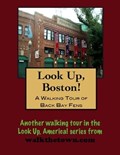There is no better way to see America than on foot. And there is no better way to appreciate what you are looking at than with a walking tour. Whether you are preparing for a road trip or just out to look at your own town in a new way, a downloadable walking tour from walkthetown.com is ready to explore when you are.
Each walking tour describes historical and architectural landmarks and provides pictures to help out when those pesky street addresses are missing. Every tour also includes a quick primer on identifying architectural styles seen on American streets.
As quickly as the Back Bay developed in the 1870s, another problem festered. A mill company’s dam’s basin became an increasingly noxious open sewer, particularly at low tide. Even then, pollution was a problem, and Bostonians demanded a solution.
Enter Frederick Law Olmsted, the co-creator of New York’s Central Park and father of American landscape architecture. He proposed to flush out the stagnant waterway and add naturalistic plantings to emulate the original tide marsh ecology of the Fenway area. His plan was true to both the character of the land and the needs of the growing population.
Today we find in the Fens different charms from the ones Olmsted created. The 1910 damming of the Charles River changed the water here from brackish to fresh, rendering his plantings unsupportable. Only two of the original “strong but unobtrusive” bridges, the parks general boundaries and some early trees remain of Olmsted’s design.
The Fens continues to be much loved and utilized. Community gardens; the elegant Kellecher Rose Garden; World War II, Korean and Vietnam War memorial; busy ball fields; and the unusual range of bird species are major attractions.
The design of the Fens today mostly reflects the work of landscape architect Arthur Shurtleff. He added the Rose Garden, turned the focus to the Museum of Fine Arts on the east side of the park, and gave us the more formal landscape style popular in the 1920s and 1930s.
This walking tour will explore the park and surrounding neighborhood, roughly east to Huntington avneue and Northeastern University, north to I-90 and west to Fenway Park...

